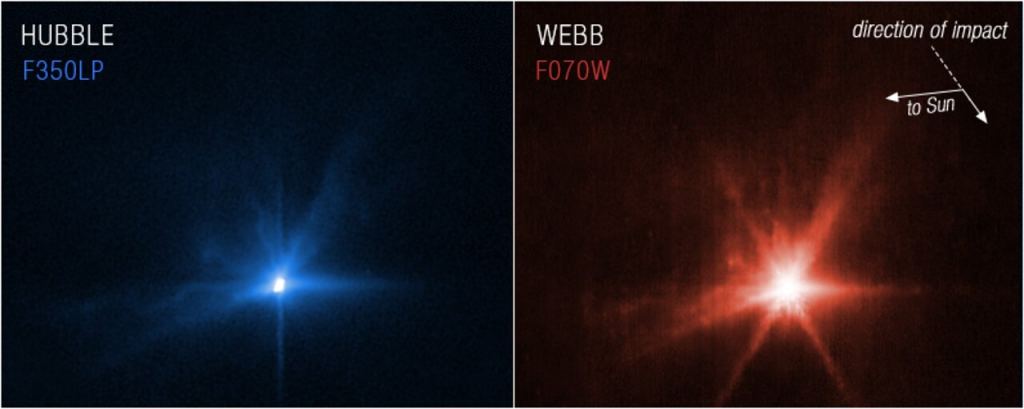What happens when you whack a little asteroid with an even littler spacecraft? People around the world watched on the 26th of September when the DART mission smashed into the side of Dimorphos. This tiny worldlet is a companion asteroid to Didymos. It was the world’s first test of the kinetic impact technique, using a spacecraft to deflect an asteroid by modifying its orbit.
Amateur observer networks and professional observatories tracked the meetup from the ground. In a first, both Hubble Space Telescope (HST) and the James Webb Space Telescope (JWST) took simultaneous images and data. Together, they managed to track the asteroid before the event.
Then, they got images and data about the ejecta (the material that got flung away from it) afterward. Each set of images showed streaks of ejecta stretching out away from the little asteroid. Scientists could even tell exactly where the spacecraft hit the asteroid.
The data should tell them about the asteroid’s composition and structure. Eventually, they should find out how much the impact affected Dimorphosis’s orbit. Doin’ it with DART The collision of spacecraft and an asteroid posed a challenge for observers.
That’s because Dimorphos and its companion Didymos move fairly quickly in their orbits. Ground-based observers were able to track the faint objects fairly well, and networks of smaller telescopes caught a view of the collision and its aftermath. For JWST, tracking that action isn’t exactly what the telescope was built for, but the teams managed.
Flight operations, planning, and science teams for JWST had to come up with a method to track the asteroids. They actually move faster than JWST was originally programmed for, so that had to be taken into account. JWST watched the event using its Near-Infrared Camera (NIRCam).
Webb observed the impact over five hours total and captured 10 images. JWST captured this sequence of the DART collision on Dimorphos. Courtesy NASA, ESA, CSA, and STScI.
HST had a little easier time of it since it successfully tracked comets, asteroids, and planets throughout its history. The telescope captured 45 images in the time immediately before and following DART’s impact with Dimorphos. An animated view captured by Hubble Space Telescope.
NASA, ESA, CSA, and STScI The Work Continues In the coming months, scientists will also use Webb’s Mid-Infrared Instrument (MIRI) and Near-Infrared Spectrograph (NIRSpec) to make more observations of Dimorphos. Hubble will monitor Dimorphos ten more times over the next three weeks to monitor how the ejecta cloud from the collisions expands and fades over time. The DART mission isn’t the first spacecraft to encounter a small solar system body.
Recall, for example, the Rosetta mission, which crash landed on Comet 67P/Churyumov-Gerasimenko. More recently, the OSIRIS-REx mission touched down briefly on asteroid Bennu to capture samples for future study. Hayabusa2 returned samples after a brief encounter with asteroid Ryugu and is on its way to study other asteroids within this decade.
Hera Follows Dart ESA’s Hera mission will head to Dimorphos in 2024 to see what DART did to this little world. Courtesy ESA/Science Office The European Space Agency is sending its Hera mission to Dimorphos in 2024 to do a post-impact study. It will be the first probe to rendezvous with a binary asteroid system and examine the aftermath of DART’s kinetic impact test.
The idea is to see how well an asteroid deflection mission could work, in the event that one is headed directly for Earth. The DART and Hera missions are in the vanguard of asteroid deflection studies. The threat of asteroid collisions on our planet is very real, and both NASA and ESA have worked together to develop asteroid monitoring networks.
The next steps, which began with DART and will continue with HERA, will find ways to avert the threat of impact. For More Information Webb and Hubble capture detailed views of DART impactThe Hera Mission The post DART Impact Seen by Hubble and Webb appeared first on Universe Today. .
From: universetoday
URL: https://www.universetoday.com/157848/dart-impact-seen-by-hubble-and-webb/



